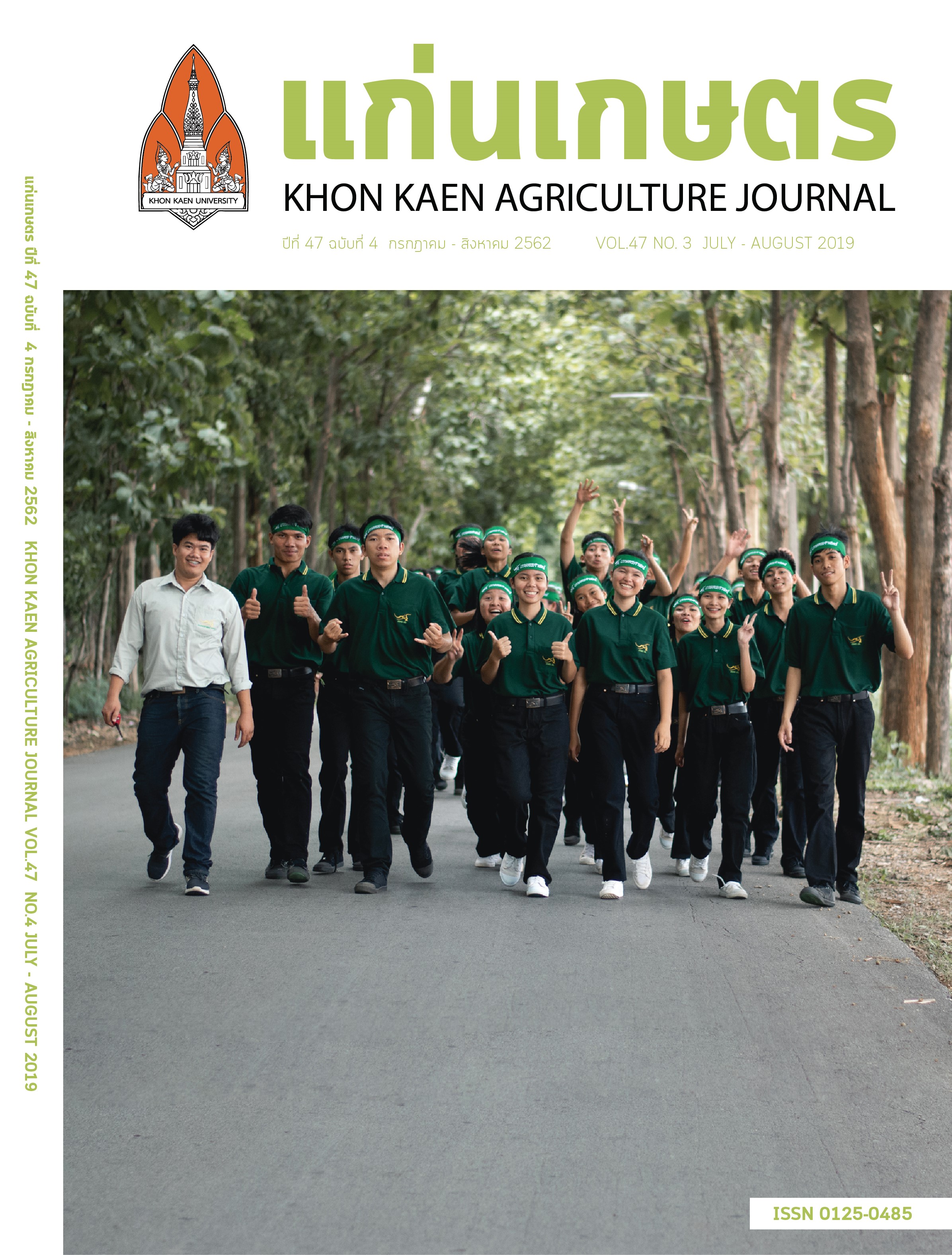ปัจจัยที่มีผลต่อการยอมรับเทคโนโลยีการปลูกอ้อยแบบให้น้ำเสริมในจังหวัดขอนแก่น
Main Article Content
บทคัดย่อ
านวิจัยนี้มีวัตถุประสงค์เพื่อศึกษาปัจจัยที่มีผลต่อการยอมรับเทคโนโลยีการปลูกอ้อยแบบให้น้ำเสริมในจังหวัดขอนแก่น กลุ่มตัวอย่างที่ศึกษาคือเกษตรกรที่ปลูกอ้อยแบบไม่ให้น้ำเสริมและให้น้ำเสริม จำนวน 216 ราย เทคนิคการวิเคราะห์องค์ประกอบ การวิเคราะห์ถดถอยโลจิสติคทวิ ถูกนำมาใช้เพื่อหาปัจจัยที่มีผลต่อการยอมรับเทคโนโลยีการปลูกอ้อยแบบให้น้ำเสริม ผลการศึกษาพบว่า อายุ การศึกษา ประสบการณ์ ประเภทเกษตรกร แหล่งน้ำ กำไรจากการผลิตอ้อย การเข้าถึงสินเชื่อ ได้รับการสนับสนุนอุปกรณ์การรับรู้เกี่ยวกับเทคโนโลยีการปลูกอ้อยแบบให้น้ำเสริมด้านการเจริญเติบโตของอ้อย (GROW) และด้านความคุ้มค่าและแรงงาน (VAWO) มีผลต่อการยอมรับเทคโนโลยีการปลูกอ้อยแบบให้น้ำเสริม อย่างมีนัยสำคัญทางสถิติที่ 0.01, 0.05 และ 0.1
Article Details
เอกสารอ้างอิง
กรมวิชาการเกษตร. 2559. ความชื้นของดินและการปลูกอ้อย. แหล่งข้อมูล:http://www.doa.go.thค้นเมื่อ 24 มกราคม 2560.
กัลยา วานิชย์บัญชา. 2554. การวิเคราะห์สถิติขั้นสูงด้วย SPSS for Windows. สำนักพิมพ์ธรรมสาร, กรุงเทพฯ.
เกรียงศักดิ์ ปัทมเรขา. 2551. การนำการเปลี่ยนแปลงการส่งเสริมการเกษตรการแพร่กระจายและการยอมรับนวัตกรรม. โรงพิมพ์
สุวรรณอักษร, สุราษฎร์ธานี.ณัฐกฤต พิทักษ์. 2547. ปัจจัยที่มีผลต่อการยอมรับเทคโนโลยีหนอนกออ้อย โดยวิธีผสมผสาน ของเกษตรกรชาวไร่อ้อยจังหวัด นครสวรรค์.วิทยานิพนธ์ปริญญาศิลปศาสตรมหาบัณฑิต. มหาวิทยาลัยเกษตรศาสตร์, กรุงเทพฯ.
ภาสวัฒน์ คงมณี. 2553. ปัจจัยทีมีผลต่อการยอมรับเทคโนโลยีการปลูกข้าวล้มตอซังของ เกษตรกร อำเภอบรรพตพิสัย จังหวัดนครสวรรค์.วิทยานิพนธ์ปริญญาวิทยาศาสตรมหาบัณฑิต มหาวิทยาลัยราชภัฏนครสวรรค์, นครสวรรค์.
ภูวนาท โง้วสุวรรณ. 2556. การยอมรับเทคโนโลยีการกรีดยางโดยใช้แก๊สเอทธิลีน. วิทยานิพนธ์ศิลปศาสตรมหาบัณฑิต มหาวิทยาลัยเกษตรศาสตร์, กรุงเทพฯ.
ยุทธ ไกยวรรณ์. 2557. การวิเคราะห์สถิติหลายตัวแปรสำหรับงานวิจัย.สำนักพิมพ์แห่งจุฬาลงกรณ์มหาวิทยาลัย, กรุงเทพฯ.วิยุทธ์ จำรัสพันธุ์. 2534. ปัจจัยที่มีอิทธิพลต่อการตัดสินใจยอมรับเทคโนโลยีสมัยใหม่ของเกษตรกร. มนุษย์ศาสตร์ สังคมศาสตร์. 9: 26 – 36.
ศุภกร ชินวรรโณ, วิริยะ เหลืองอร่าม, จุฑาทิพย์ ธนกิตติ์เมธาวุฒิ, และวิเชียร เกิดสุข. 2552. ภาวะโลกร้อนและการเปลี่ยนแปลง สภาพภูมิอากาศในลุ่มน้ำชี-มูล. วิจัย มข. 14: 666–682.
สกุล ภาวศุทธิกุล. 2551. ปัจจัยที่มีผลต่อการยอมรับเทคโนโลยีการปลูกข้าวชีวภาพ ในจังหวัดสุพรรณบุรี. วิทยานิพนธ์ปริญญา วิทยาศาสตรมหาบัณฑิต มหาวิทยาลัยเกษตรศาสตร์, กรุงเทพฯ.สำนักงานคณะกรรมการอ้อยและน้ำตาลทราย. 2559. รายงานพื้นที่ปลูกอ้อย. แหล่งข้อมูล: http://www.ocsb.go.th/th/home/index. php. ค้นเมื่อ 12 พฤศจิกายน 2559.
Abdulai, A., V. Owusu, and J.E. A.Bakang. 2011. Adoption of safer irrigation technologies and cropping patterns: Evidence from Southern Ghana. Ecol Econ. 70: 1415–1423.
Adeoti, A. I. 2008. Factors influencing irrigation technology adoption and its impact on household poverty in ghana. J Agr Rural Dev Trop. 109: 51–63.
Adesina, A. A., and M. M. Zinnah. 1993. Technology characteristics, farmers’ perceptions and adoption decisions: A tobit model application in Sierra Leone. Agri Econ. 9: 297 – 311.
Alcon, F., M. D. De Miguel, and M. Burton. 2011. Duration analysis of adoption of drip irrigation technology in southeastern Spain. Technol Forecast and Soc Change. 78: 991–1001.
Hair, J. F. 2006. Multivariate Data Analysis 6th Edition. Pearson prentice Hall, New Jersey.Kiruthika, N. 2014. Determinants of adoption of drip irrigation in sugarcane cultivation in Tamil Nadu. American International Journal of Research in Humanities, Arts and Social Sciences. 5: 143–146.
Margaret, M. and Samuel, K. 2015. Factors determining adoption of new agricultural technology by smallholder farmers in developing countries. J Econ Sustain Dev. 6: 208-217.
Mariano, M. J., R. Villano, and E. Fleming. 2012. Factors influencing farmers’ adoption of modern rice technologies and good management practices in the Philippines. Agric Sys. 110: 41–53.
Mauceri, M., J. Alwang, G. Norton, and V. Barrera. 2005. Adoption of integrated pest management technologies: A case study of potato farmers in Carchi, Ecuador. Paper presented at the American Agricultural Economics Association annual meeting July 24-27, 2005. Providence, Rhode Island.
Mignouna, D. B., V. M. Manyong, K. D. S. Mutabazi, and E. M. Senkondo. 2011. Determinants of adopting imazapyr-resistant maize for striga control in Western Kenya. J Dev Agri Econ. 3: 572–580.
Peiris, T., N. R. Abeynayake, and M. S. Perera. 2012. Socio-economic factors affecting the technology adoption level of sugarcane in rainfed sector in Sevenagala. J Sci Food Agri. 2: 215 – 224
Rogers, E.M. 2003. Diffusion of Innovations. Simon and Schuster, New York.
Simtowe, F., Kassie, M., Diagne, A., Silim, S., Muange, E., Asfaw, S. and Shiferaw, B. 2011. Determinants of agricultural technology adoption: The case of improved pigeonpea varieties in Tanzania. Q J Int Agr. 50: 325–345.
Tey, Y.S. and M. Brindal. 2012. Factors influencing the adoption of precision agricultural technologies. Precis Agric. 13: 713–730.
Xue-Feng, H., H. Cao, and F. M. Li. 2007. Econometric analysis of the determinants of adoption of rainwater harvesting and supplementary irrigation technology (RHSIT) in the semiarid Loess Plateau of China. Agric Water Manag. 89: 243–250.


